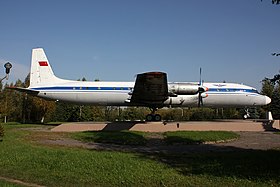Aeroflot flight 25
| Aeroflot flight 25 | |
|---|---|
|
Identical aircraft of the airline |
|
| Accident summary | |
| Accident type | Loss of control |
| place | 3.5 km southwest of Urakhtscha , Rybnaya Sloboda , Tatarstan , Russian SFSR |
| date | April 4th 1963 |
| Fatalities | 67 |
| Survivors | 0 |
| Aircraft | |
| Aircraft type |
Ilyushin Il- 18V, Russian SFSR |
| operator |
Aeroflot , Russian SFSR |
| Mark | CCCP-75866, Russian SFSR |
| Departure airport |
Moscow Sheremetyevo Airport , Russian SFSR |
| Destination airport |
Yemelyanovo Airport , Russian SFSR |
| Passengers | 59 |
| crew | 8th |
| Lists of aviation accidents | |
On April 4, 1963, an Ilyushin Il-18 crashed on the inner-Soviet scheduled flight Aeroflot flight 25 from Moscow to Krasnoyarsk , killing all 67 inmates, including the Soviet chess player Igor Georgievich Rubel .
plane
The aircraft was an Ilyushin Il-18 W ( aircraft registration number : CCCP-75866 , serial number: 183005901) that was less than 1 year old and had completed 154 operating hours and 68 flight cycles from the start of operation on February 26, 1963 until the accident.
course
The Il-18 took off from Moscow at 3:12 a.m. and rose to an altitude of 6,000 m and thus above the clouds. Shortly thereafter, the pilots asked flight control to be allowed to increase to 8,000 m in favor of fuel consumption, but this was refused because at that time a Tupolev Tu-104 was traveling at this altitude on the same airway in the same direction. At 4:15 a.m., the pilots of the Tu-104 reported via Kanasch , 40–50 km ahead of the Il-18, whereupon the pilots of the Il-18 were given clearance to climb to 8,000 m at 4:22 a.m. Another 4 minutes later the pilots of the Il-18 reported the overflight of Laischewo at 7,500 m, heading for Mamadysch . This was the last radio contact with the pilots. Another radio message from flight control at 4:30 a.m. was not answered.
After sunrise, the wreck was found in a snow-covered field, 54.5 km east of Laischewo, 82 km southeast of Kazan and 3.5 km southwest of Urachcha in the direction of 75 ° (northeast).
Weather
At the time of the accident, it was very cloudy around the scene of the accident with an upper cloud limit of 7,500 m and a lower limit at an altitude of 200–300 m. There were also showers with a visibility of 6–8 km and a wind from the direction of 160 ° (southeast).
detection
The debris field had a length of 800 and a width of 250 m. The impact occurred with the landing gear retracted and with a small, negative pitch angle and almost no bank angle at a speed of 500–600 km / h. Previously, the aircraft fell to the ground from a height of 7,800 m within 4–4.5 minutes at an average rate of descent of 30 m / s and a true flight speed of an average of 650 km / h. It could also be determined that thrusters No. 1 and No. 2 (both left) had worked normally until then, while thrusters No. 3 and No. 4 (both right) did not and their propellers were brought into the sail position had been. Since the corpses of the passengers were not injured, a pressure drop was excluded. The weather was also ruled out as an immediate cause, but the investigators suspected that the poor visibility in the clouds had made interception difficult, although the aircraft was controllable and largely intact. After the snowmelt, residents found the outer ailerons of both wings 11–12 km from the point of impact. These tore off in flight due to the extremely high airspeed.
During the examination of engines no. 3 and no. 4 it was found that first no. 4 and then no. 3 were switched off and that neither had previously failed. They were then brought into the feathered position either automatically or by pressing the appropriate buttons. Evidence of a propeller control malfunction was found on engine # 4 due to a failure of the oil seal ring for the oil adapter; he was responsible for the oil transport into the engine. The malfunction happened due to an error in the manufacture of the propeller. This caused the speed control spool to jam. This fault in the engine could never have been discovered in flight, but only if the propeller had been removed from the engine during maintenance.
Ultimately, engine no. 4 switched to thrust reversal in flight at an altitude of almost 8 km , which created a lot of air resistance . As a result , the aircraft leaned to one side, could no longer maintain the altitude and went into a dive . Since the pilots could not see which engine was on reverse thrust, they switched off engines No. 3 and No. 4. They lost their orientation at the high speed and rate of descent in the clouds and gained control when the aircraft broke through the cloud cover at 150–200 m. Due to the high rate of descent, they could not prevent the impact.
swell
- Aircraft accident data and report CCCP-75866 on the Aviation Safety Network , accessed July 23, 2019.
- Description of the accident on airdisaster.ru (Russian) , accessed on July 23, 2019
